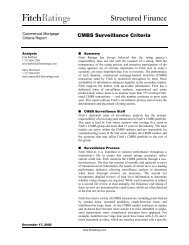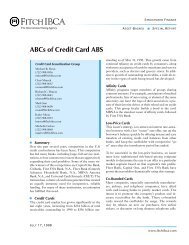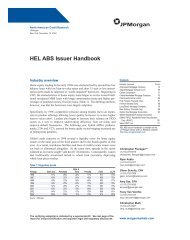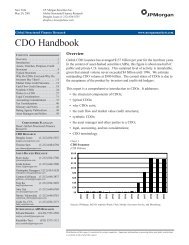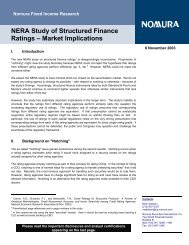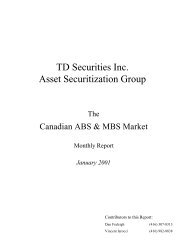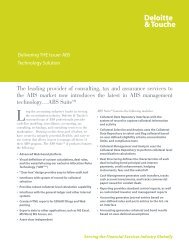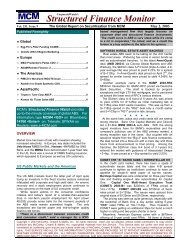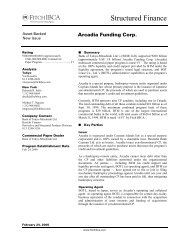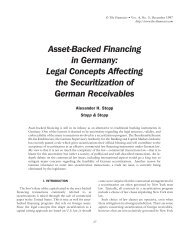Asset Backed Securities: A Practical Guide for ... - Securitization.Net
Asset Backed Securities: A Practical Guide for ... - Securitization.Net
Asset Backed Securities: A Practical Guide for ... - Securitization.Net
Create successful ePaper yourself
Turn your PDF publications into a flip-book with our unique Google optimized e-Paper software.
<strong>Asset</strong> <strong>Backed</strong> <strong>Securities</strong><br />
PRACTICAL GUIDE FOR INVESTORS<br />
This guide is an introduction to ABS, presented from the point of view of the investor. It<br />
proposes a breakdown in simple notions, which enable a partial reading. A glossary, in<br />
the last page, regroups the main technical terms and indicates where they appear <strong>for</strong><br />
the first time in the text (also outlined in italic)<br />
.<br />
I<br />
What is an ABS?<br />
ABS (<strong>Asset</strong> <strong>Backed</strong> <strong>Securities</strong>) are<br />
experiencing strong growth on the capital markets.<br />
These financial instruments enable companies to<br />
raise capital using the securitisation method<br />
described below.<br />
Securitisation. Securitisation is a way <strong>for</strong><br />
companies to raise capital and consists in using one<br />
of the company's financial assets to guarantee a<br />
security issued on the capital markets.<br />
Let us take the example of an industrial<br />
manufacturer with an average credit rating, who is<br />
experiencing difficulties in obtaining financing from<br />
banks. This manufacturer has sold capital goods to<br />
customers with a strong credit rating. The idea<br />
behind securitisation is to structure a financing<br />
package backed by these high quality trade account<br />
receivables. In this way repayment no longer<br />
depends on the manufacturer, but only on the<br />
customers' ability to pay <strong>for</strong> the goods.<br />
A company is created <strong>for</strong> this purpose (SPV<br />
or Special Purpose Vehicle). The manufacturer (the<br />
Seller) sells the portfolio of trade account receivables<br />
(the underlying asset) to the SPV. The SPV then<br />
refinances this purchase by issuing rated securities,<br />
with repayment of these debts depending on the<br />
customers' (the final debtors') ability to pay.<br />
ABCP, MBS and ABS. <strong>Securities</strong> issued using<br />
the securitisation method are called "Term Deals" if<br />
they are offered to the markets as a long-term bond<br />
and "Conduits" if they are short-term.<br />
ABCP. Conduits are mainly refunded by<br />
issuing commercial paper. These securitisation<br />
programmes, known as <strong>Asset</strong> <strong>Backed</strong> Commercial<br />
Paper (ABCP) accounted <strong>for</strong> a total outstanding of<br />
more than USD 500bn in the US in 1999, (i.e. more<br />
than a quarter of the US commercial paper market).<br />
MBS. Term deals where the underlying assets<br />
comprise mortgage loans are called Mortgage <strong>Backed</strong><br />
<strong>Securities</strong>. These represent a highly specific market<br />
and are mainly traded on the US domestic market.<br />
MBSs are generally fixed rate and their risk is<br />
principally linked to early repayment of the<br />
underlying mortgage loans. More than USD 400bn<br />
MBSs were issued in the US in 1999.<br />
ABS. ABSs are all the Term Deals which do<br />
not fall under the MBS category: unlike MBSs, ABSs<br />
are mostly floating rate notes and principally carry a<br />
credit risk. In 1999, approximately USD 350bn of<br />
ABSs (excluding MBS) were issued.<br />
HEL<br />
AUTO<br />
USD assets only<br />
Graph 1 : ABS issued in 1999<br />
14%<br />
25%<br />
OTHERS<br />
14%<br />
CARD<br />
15%<br />
7%<br />
CMBS<br />
CBO/CLO<br />
25%<br />
TOTAL ABS $ 350 Billion<br />
Fast-developing. Since 1996, ABSs have<br />
accounted <strong>for</strong> one of the strongest growth segments<br />
in the capital markets and are also developing<br />
outside of the US (issuance volume on the European<br />
market was USD 75bn in 1999).<br />
On the whole, this trend can be explained by<br />
increasing pressure from shareholders, which leads<br />
more and more companies to deconsolidate financial<br />
or property assets in order to optimise their Return<br />
On Equity (ROE).<br />
In the same way, in<strong>for</strong>mation on ABSs is<br />
increasingly available and transactions are<br />
progressively standardised, leading to more<br />
transparency.<br />
Finally, ABSs are often sold as variable rate<br />
securities, and benefit enormously from growth in<br />
the credit market, while offering an attractive means<br />
of diversifying investments, especially in Europe.<br />
SG does not make any representations or warranty, express or implied, as to, nor does it assume any responsibility or liability<br />
<strong>for</strong>, the authenticity, origin,validity or completeness of, or any omissions in any in<strong>for</strong>mation contained in this document.<br />
SG ABS RESEARCH – updated 15/05/2000 1
Market segments. Each securitisation is, to<br />
a large extent, characterised by its underlying asset.<br />
According to this criteria, the ABS market can be<br />
divided into several segments:<br />
US household debt (around USD 5000bn)<br />
represented the first pool of securitisable assets<br />
which gave rise to MBSs and to the main ABS<br />
categories, according to the type of asset: Credit<br />
Cards, Home Equity Loans or HEL (consumer loans<br />
secured by mortgages), Auto Loans, and Student<br />
Loans.<br />
The "Credit Card" type of ABS has<br />
experienced steady growth over the last ten years<br />
and account <strong>for</strong> the most mature and standardised<br />
segment of the market, with USD 50bn of new issues<br />
in 1999. US consumer loan organisations do not<br />
dispose of a large amount of capital and securitise<br />
their outstanding credit card debt heavily: they turn<br />
to the markets several times a year and each time sell<br />
a portfolio of around USD 1bn of outstanding on<br />
thousands of individual debtors over the entire US.<br />
Since 1996, the increase in ABSs has been<br />
greatly helped by CLO, CBO and CMBS securitisation<br />
types: to maximise their capital, financial institutions<br />
have proceeded with a large scale deconsolidation of<br />
their loan portfolios (Collateralised Loan Obligation<br />
or CLO), security portfolios (Collateralised Bond<br />
Obligation or CBO), or commercial property<br />
portfolios (Commercial Mortgage <strong>Backed</strong> <strong>Securities</strong> or<br />
CMBS). By way of example, the volume of CBOs and<br />
CLOs issued worldwide in 1999 was almost twice the<br />
volume of of "Credit Card" type ABSs issued.<br />
II<br />
5 stages in<br />
evaluating an ABS<br />
The main difficulty faced by an investor lies<br />
in evaluating the offered security within a reasonable<br />
time frame. This section suggests a method of<br />
breaking down an ABS into its five component parts:<br />
underlying asset, credit enhancement, cashflow<br />
mechanics, legal structure and links with the seller.<br />
Stage 1: Underlying assets<br />
In a securitisation, the analysis of the<br />
underlying asset is crucial: whether the issued<br />
securities are repaid depends in the first instance on<br />
its strong or weak per<strong>for</strong>mance. The main points to<br />
study are: the quality of the final debtors, the<br />
monitoring of the portfolio the maturity of the<br />
receivables, and finally how these loans were set up.<br />
Debtors. It is possible to distinguish<br />
between securitisations where the final debtors are<br />
individuals, and those which have companies as the<br />
final debtors. Risk linked to a portfolio containing<br />
many hundreds of thousands of US households'<br />
consumer loans can be seen as purely statistical and<br />
strongly linked to the economic environment,<br />
whereas a portfolio of, <strong>for</strong> example, twenty company<br />
loans needs to be analysed debtor by debtor, since<br />
each one accounts <strong>for</strong> a larger proportion of the<br />
underlying asset.<br />
The credit risk of securitisations backed by<br />
individuals is little correlated to securitisation<br />
backed by companies.<br />
Reporting. When a transaction is set up,<br />
credit rating agencies require frequent reporting,<br />
following a predetermined set of criteria, to assess<br />
the development quality of the underlying asset. For<br />
household consumer loan portfolios, global<br />
statistical data is enough to describe the portfolio<br />
(net yield rate, geographical distribution of debtors).<br />
Conversely, ten office blocks will need detailed<br />
asset-by-asset reporting (vacancy rate, description of<br />
the tenants, rents).<br />
The Diversity Score is a standardised<br />
indicator to measure the diversity of a corporate loan<br />
portfolio: if, <strong>for</strong> example, a portfolio of 200 loans has<br />
a score of 50, this means that the portfolio is<br />
equivalent to a hypothetical group of fifty loans to<br />
uncorrelated companies. This calculation, made by<br />
credit rating agencies, is based on the correlation<br />
between different economic sectors.<br />
Maturity. To fully understand an underlying<br />
asset, a distinction needs to be made between longterm<br />
and short-term assets: in order to be refunded<br />
by a long-term bond, a portfolio of 30-day<br />
commercial debts should be renewable. This means<br />
that with the repayments, the SPV will buy new debts<br />
from the seller over, <strong>for</strong> example, a five year<br />
reinvestment period.<br />
On the contrary, a portfolio of 15-year<br />
mortgage loans does not require a reinvestment<br />
period. This portfolio is referred to as static: it does<br />
not change during the course of the transaction and<br />
is amortised with each repayment. A static portfolio<br />
has the advantage of being completely transparent<br />
from the beginning of the transaction.<br />
For a renewable portfolio, agencies<br />
safeguard against a deterioration in quality of the<br />
original portfolio by imposing stringent criteria on<br />
reinvestments. The more short-term the asset, the<br />
greater the turn-over, which in turn makes <strong>for</strong> more<br />
dynamic structure management, thus guarding<br />
against a deterioration in quality by adding superior<br />
quality investments.<br />
Origination. Origination covers the entire<br />
process <strong>for</strong> setting up a new loan. In most cases<br />
financial assets are created during the day-to-day<br />
business of the seller: consumer loans, syndicated<br />
loans to leading companies, and trade account<br />
receivables following the sale of capital goods. By<br />
studying the procedure <strong>for</strong> granting loans<br />
(circulation of the credit profile, scoring method), it<br />
is possible to see how the final debtor's credit risk<br />
was calculated and checked by the seller. The more<br />
selective the origin, the easier it is to get an idea of<br />
the underlying asset.<br />
SG does not make any representations or warranty, express or implied, as to, nor does it assume any responsibility or liability<br />
<strong>for</strong>, the authenticity, origin,validity or completeness of, or any omissions in any in<strong>for</strong>mation contained in this document.<br />
SG ABS RESEARCH – updated 15/05/2000 2
The origination is more important when the<br />
transaction includes a reinvestment phase in new<br />
assets, due to be generated at a later date. Certain<br />
ABSs, of the "Future flows" type, are securitisations of<br />
future receivables which do not yet exist: <strong>for</strong><br />
example, an oil company can securitise income in<br />
dollars, received in exchange <strong>for</strong> expected oil sales<br />
over the next two years. To take this extreme<br />
example, the securitised portfolio is only described<br />
by the asset creation procedure, i.e. a description of<br />
the oil selling process.<br />
Stage 2: Credit enhancement<br />
To optimise refunding costs, securities sold<br />
on the market are generally awarded a high credit<br />
rating from credit rating agencies: <strong>for</strong> example AAA,<br />
the highest rating, means that there is only a slight<br />
possibility of default on the security. It is rare to find<br />
an underlying asset in a securitisation which has<br />
sufficient quality of its own, to obtain this rating. A<br />
portfolio of several thousand debtors will inevitably<br />
contain some defaults in payment.<br />
Credit enhancement is a means of absorbing<br />
these defaults, in such a way that they do not affect<br />
the quality of issued securities. The more the<br />
security benefits from credit enhancement, the less<br />
the risk of default. In a transaction comprising<br />
several risk profiles, the senior tranche is the one<br />
with the most credit enhancement.<br />
Methodology. A credit rating assesses the<br />
ability of issuers to withstand worst case scenarios.<br />
There<strong>for</strong>e, to designate an AAA rating to the senior<br />
tranche of an ABS, the credit rating agencies demand<br />
that the overall structure is able to withstand a<br />
worst-case increase in defaults in the underlying<br />
portfolio, without the senior tranche being subject to<br />
default.<br />
For a diversified portfolio, historical<br />
statistical data (standard deviation) can be used to<br />
predict worst-case scenarios: <strong>for</strong> example, to obtain<br />
AAA status, the SPV should be able to fully repay<br />
senior debt obligations, even if the underlying asset<br />
experiences a sudden default on payment equal to<br />
[4] times the annual loss rate, the highest over the<br />
last [5] years. These scenarios are even more relevant<br />
given that a reliable database exists, which is the<br />
case <strong>for</strong> US consumer loans. If the credit rating<br />
agency does not have access to reliable historical<br />
data, this does not imply that the AAA rating cannot<br />
be achieved, but simply that the agency insists on a<br />
larger multiplier coefficient.<br />
This statistical approach is generally<br />
complemented by an asset by asset approach, paying<br />
particular attention to debtors with a substantial<br />
concentration of debts or debtors with a high risk<br />
profile. This approach is used with CLOs where the<br />
underlying asset is comprised of loans to final<br />
debtors, rated by agencies or scored by the seller<br />
bank. In this case the credit rating agency demands a<br />
worst-case scenario which takes the <strong>for</strong>m of a<br />
simultaneous default of all debtors who account <strong>for</strong><br />
more than [1%] of the portfolio, as well as all debtors<br />
with a rating below [BBB-].<br />
Finally, the credit report level required to<br />
obtain AAA status, depends on more qualitative data,<br />
which in turn depends on the nature of the assets<br />
and more generally on the technical and legal<br />
securitisation environment.<br />
All credit rating agencies have teams of<br />
analysts specialised in structured finance, and follow<br />
market developments with the publication of<br />
increasingly standardised quantitative and<br />
qualitative methods. However, the agency still<br />
examines each transaction on an individual case<br />
basis, with a due diligence visit to the seller, to<br />
guarantee reliability of the credit rating.<br />
In order to withstand the worst-case<br />
scenarios predicted by the agencies, a securitisation<br />
structure can use several credit enhancement<br />
techniques. The main ones are:<br />
Subordination (see graph 2). To finance a<br />
portfolio of 100, the issue will be composed of a<br />
rated tranche of 92 (senior tranche). The remaining 8<br />
will be financed by a non-rated subordinated tranche,<br />
that is, repayable only after other senior debts have<br />
been repaid in full. There<strong>for</strong>e, the subordinated<br />
tranche absorbs the first losses on the underlying<br />
asset, up to 8, without the senior tranche being<br />
affected.<br />
In addition to the senior tranche (often<br />
called "Class A") and the most subordinated tranche<br />
(sometimes incorrectly referred to as "Equity"), the<br />
structures often contain several intermediary<br />
tranches ("mezzanines"), called Classes B, C, D,<br />
according to their subordination level. Each of these<br />
classes can be split into several tranches of different<br />
maturities (<strong>for</strong> example tranches A-1 and A-2 of class<br />
A), however, the level of risk remains the same.<br />
Excess Spread (see graph 2). This is the<br />
spread between the yield of the underlying portfolio<br />
(<strong>for</strong> example Libor+1.00%)and the interest payable to<br />
holders of the rated tranches (<strong>for</strong> example<br />
Libor+0.10%). In theory, providing all goes well,<br />
residual flow surplus is paid to the holder of the<br />
most subordinated tranche in payment <strong>for</strong> risks<br />
taken (in our example 0.90%p.a.). However, this<br />
payment depends on whether the structure is<br />
per<strong>for</strong>ming well: in the event that the per<strong>for</strong>mance of<br />
underlying assets falls below a predetermined level,<br />
the Excess Spread is used to repay the rated<br />
tranches, and in this respect, represents an<br />
additional credit support.<br />
SG does not make any representations or warranty, express or implied, as to, nor does it assume any responsibility or liability<br />
<strong>for</strong>, the authenticity, origin,validity or completeness of, or any omissions in any in<strong>for</strong>mation contained in this document.<br />
SG ABS RESEARCH – updated 15/05/2000 3
Graph 2 : Credit enhancement<br />
SPV<br />
Underlying<br />
debtors<br />
Libor + 1.00%<br />
<strong>Asset</strong>s<br />
Liabilities<br />
Senior 92<br />
Collateral 100<br />
Subordinated 8<br />
A1+/ P1 <strong>Asset</strong>s 0.5 Cash Deposit 0.5<br />
Libor + 0.10%<br />
Excess Spread<br />
0.90% p.a.<br />
Senior<br />
investors<br />
Subordinated<br />
investors<br />
Subordination : 8%<br />
Cash Deposit : 0.5% => Total credit enhancement : 9.40%<br />
Excess Spread : 0.90% p.a.<br />
Cash deposit (see graph 2). On the whole<br />
credit rating agencies require the seller to pay a cash<br />
deposit to the SPV, repayment of which is ranked the<br />
same as the most subordinated tranche. The SPV will<br />
then reinvest this amount in liquid financial<br />
instruments rated A1+/P1 (<strong>for</strong> example treasury<br />
bills), which can then immediately be cashed to pay<br />
the holders of the senior tranches, if necessary.<br />
Certain structures sometimes allow <strong>for</strong> part of the<br />
Excess Spread to pay the Cash Deposit.<br />
Guarantee. Certain structured transactions<br />
use credit enhancing guaranteed by a third party (a<br />
bank, an insurance company): in case of default, the<br />
guarantor is substituted <strong>for</strong> the issuer of the security<br />
and is obliged to repay. US insurance companies,<br />
generally rated AAA (the monolines) expanding in<br />
financial insurance: they insure payment of a<br />
security on a specific date, which is also ranked AAA,<br />
by the insurance company. In general they only<br />
insure risks already considered as investment grade<br />
(i.e. of minimum ranking BBB-/Baa3): <strong>for</strong> a<br />
securitisation, if the underlying asset has a lower<br />
average ranking, it needs to be upgraded by other<br />
means to BBB status be<strong>for</strong>e the monoline will<br />
guarantee it, and accord the security a AAA rating.<br />
For example, a BB portfolio will have a credit<br />
enhancement using a subordinated tranche in order<br />
to achieve a BBB rated senior tranche: this tranche<br />
will be guaranteed by the monoline.<br />
Stage 3: cashflow mechanics<br />
The SPV's only source of income is the flow<br />
of payments from final debtors related to the<br />
underlying asset. Payments originating from the<br />
redemption in capital of debtors are entered in the<br />
accounts as principal collections. Interest collections<br />
include the interest paid by debtors, but also,<br />
overdue penalties and operating costs (particular<br />
case: the trade receivables do not bear interests,<br />
however, a receivable with a value of 100 to be<br />
received in 3 months, will be sold 99 to the SPV,<br />
which enable to consider 99 in principal and 1 in<br />
interest).<br />
The allotment of incoming payments is set<br />
out in full in the legal documentation. It is important<br />
to understand the principles of payment allocation<br />
as the order of subordination of the various tranches<br />
depends on this.<br />
Reinvestment. If the structure is<br />
rechargeable, the period of reinvestment needs to be<br />
analysed separately from the period of repayment.<br />
During the initial phase, principal collections are<br />
reinvested in new eligible assets in order to ensure<br />
the consistency of the quality of the underlying.<br />
During this phase, and similarly, during the<br />
phase of amortisation, interests and fees collections<br />
are mainly allocated to the interest payments of<br />
securities in the order of subordination of the<br />
various tranches.<br />
SG does not make any representations or warranty, express or implied, as to, nor does it assume any responsibility or liability<br />
<strong>for</strong>, the authenticity, origin,validity or completeness of, or any omissions in any in<strong>for</strong>mation contained in this document.<br />
SG ABS RESEARCH – updated 15/05/2000 4
Repayment. After the reinvestment phase,<br />
if there is one, and otherwise from the outset,<br />
principal collections are used to repay the different<br />
tranches.<br />
When the underlying asset consists of a<br />
large number of debtors, principal collections are<br />
daily. These amounts are placed by the SPV in highly<br />
liquid A1+/P1 rated assets, in preparation <strong>for</strong><br />
payment, to take place on a coupon due date (usually<br />
monthly or quarterly).<br />
A security to be repaid on a pre-determined<br />
date is known as a Hard Bullet: if the security is not<br />
repaid on this date, this constitutes a default. Unlike<br />
standard bond issues, the Hard Bullet is very rarely<br />
used in securitisation operations.<br />
The Soft Bullet (see graph 3) is one of the two<br />
most frequently employed repayment methods: all<br />
principal collections are placed in one of the SPV's<br />
accounts. Only when there is sufficient capital in the<br />
account will the A tranche be repaid, in one<br />
instalment. Subsequently, the process of<br />
accumulation will continue in order to repay the B<br />
tranche afterwards, then C, and so on.<br />
A Pass-Through type redemption is one<br />
where principal collections are fully repaid on the<br />
next coupon due date to holders of class A securities,<br />
and when these have been repaid in full, to holders<br />
of class B securities. This method is generally used<br />
when the rate of principal collections is slower (<strong>for</strong><br />
example, long-term assets) in which case it would be<br />
uneconomical to accumulate the reinvested amounts<br />
in low-yielding instruments while awaiting a bullet<br />
payment.<br />
Some structures make use of Controlled<br />
Amortisation. which is a type of Pass-Through<br />
repayment. However, if payment in principal is<br />
greater than expected over a certain period, a<br />
specific amount is retained in the structure. This<br />
enables smoothing of the repayment profile to make<br />
it as linear as possible.<br />
Rapid amortisation. Throughout the entire<br />
life span of the transaction, the quality of the<br />
structure is monitored by regular reports submitted<br />
to credit rating agencies. Each indicator in the report<br />
has a threshold level (a Trigger). If this level is<br />
reached it triggers a further sequence of allocation of<br />
flows so as to maintain the quality of the rated<br />
tranches:<br />
If triggering takes place during the<br />
reinvestment phase (see graph 4), this phase will<br />
come to an end, and the amounts paid in principal<br />
will be used to repay bondholders in a pass-through<br />
mode (to avoid to retain cash in the structure). At the<br />
same time, the Excess Spread will no longer be paid<br />
to holders of the lowest ranking tranche, but will be<br />
used to repay holders of rated tranches. As a general<br />
rule, all amounts received will be used to repay the<br />
tranches as fast as possible.<br />
Repayment date. The Expected Maturity is<br />
the most likely repayment date according to<br />
simulations carried out on the structure. When<br />
securitisation takes place, the effective repayment<br />
date of securities may differ from the expected<br />
maturity without constituting a default clause. The<br />
legal cut-off date <strong>for</strong> repayment of securities is said<br />
to be Legal Final. On this date, if securities have not<br />
yet been repaid, default is declared and the structure<br />
is liquidated to cover securities which are as of yet<br />
unpaid, according to the predetermined order of<br />
payment.<br />
The first factor causing deviation between<br />
the expected and actual repayment date is the<br />
variation in the rapidity of repayment of debtors in<br />
relation to the original scenario. This risk is<br />
important <strong>for</strong> MBSs, and investors generally have a<br />
chart linking expected maturity to the early<br />
repayment rate of underlying debtors. On the other<br />
hand, this is fairly unlikely in the case of a shortterm<br />
asset (such as credit card receivables), or when<br />
the underlying debtors do not possess an early<br />
repayment option (such as syndicated corporate<br />
loans to businesses). Securitisations of long term<br />
assets often incorporate a Clean-up Call, i.e. the<br />
possibility of liquidating the structure when the<br />
outstanding falls below 10% of initial value.<br />
Outstanding<br />
Graph 3 : Soft bullet repayment<br />
Outstanding<br />
Graph 4 : Rapid amortisation (Pass through)<br />
100<br />
100<br />
Tranche A<br />
senior<br />
cash<br />
Tranche A<br />
senior<br />
cash<br />
Tranche B<br />
mezzanine<br />
Tranche B<br />
mezzanine<br />
Tranche C subordinated<br />
Tranche C subordinated<br />
0 1 2 3 4 5 6 7 Years<br />
0 1 2 3 4 5 6 7 Years<br />
SG does not make any representations or warranty, express or implied, as to, nor does it assume any responsibility or liability<br />
<strong>for</strong>, the authenticity, origin,validity or completeness of, or any omissions in any in<strong>for</strong>mation contained in this document.<br />
SG ABS RESEARCH – updated 15/05/2000 5
The second factor contributing to<br />
uncertainty hinges on early repayment should an<br />
emergency procedure be triggered. This scenario<br />
appears under extremely precise circumstances, and<br />
depends on legally predetermined trigger targets. To<br />
date, early repayment has never affected standard<br />
ABS categories such as credit cards. If the emergency<br />
procedure is triggered, this indicates abnormal<br />
deterioration of the underlying, which is better than<br />
a default. In general, triggers apply to averaged<br />
figures, to avert the triggering of early repayment by<br />
an insignificant poor per<strong>for</strong>mance over a month.<br />
For each transaction, repayment risk should<br />
be examined in each individual case. However, a<br />
distinction is being made with increasing frequency<br />
between pure credit products such as ABSs, where<br />
uncertainty is reduced by a maximum, and MBSs<br />
where repayment risk is an important factor in price<br />
mechanisms: CMOs (Collateralised Mortgage<br />
Obligation), securitisations of MBS portfolios, are<br />
transactions which offer investors high profit<br />
profiles by exerting a leverage effect on the<br />
repayment rate of underlying debtors.<br />
Master-Trust: this is a super SPV, which can<br />
be re-used <strong>for</strong> several consecutive transactions, by<br />
issuing individualised series (<strong>for</strong> example "serie 98-<br />
1" represent the first transaction in 1998 <strong>for</strong> this<br />
seller). Each serie is backed by the same underlying<br />
receivables pool, and each time the seller carries out<br />
a new securitisation, he add underlying assets to the<br />
total portfolio. Collections in principal and interest is<br />
allocated pro rata in each serie.<br />
Each serie then has its own cashflow<br />
mechanics and amortisation profile. The use of a<br />
universal structure enables amortisation of fixed<br />
costs, but above all, the constitution of an extremely<br />
large and diversified underlying portfolio developed<br />
over consecutive operations. This technique is<br />
mainly employed by credit card institutions which<br />
frequently turn to the markets <strong>for</strong> financing: some<br />
Master Trusts contain over 30 series.<br />
With the exception of the underlying asset,<br />
each serie may be analysed in financial terms as a<br />
separate SPV. However, some Master Trusts establish<br />
solidarity between series: if a serie defaults, the<br />
Excess Spread of another, stronger serie may be used<br />
to support the weaker series.<br />
Stage 4: Legal structure<br />
ABS transactions are often given outlandish<br />
names, ranging from the name of a flower to an<br />
unpronounceable sequence of letters. This name<br />
refers to the legal structure which issues the<br />
securities and which has been created specifically to<br />
this effect.<br />
Special Purpose Vehicle (SPV) The<br />
securitisation structure is a company specifically<br />
created <strong>for</strong> this purpose, whose assets consist of the<br />
disposed underlying asset and which is refinanced<br />
by issues of securities. Some countries benefit from<br />
legal securitisation structures; as in France (Fonds<br />
Communs de Créances (FCC)). However, most<br />
securitisations are issued by offshore vehicles which<br />
side-step the restrictions of domestic legislation.<br />
(The laws ruling FCCs have recently been relaxed,<br />
showing increasing resemblance to Anglo-Saxon<br />
style SPVs).<br />
SPVs are established in Jersey, in the<br />
Cayman Islands, and in Delaware, <strong>for</strong> technical<br />
reasons: ease of registration, absence of the need <strong>for</strong><br />
a physical board of directors, reduced costs, and<br />
uni<strong>for</strong>mity of structure. The use of tax havens is not<br />
motivated by the desire to hide from the domestic<br />
legislator: the practice of offshore securitisation is<br />
widely recognised by most major states, as in any<br />
case, the operation must be approved by the local<br />
authorities, which decide on the deconsolidating<br />
nature of the structuring (i.e. the possibility of offbalance<br />
sheet accounting <strong>for</strong> the seller).<br />
Underlying<br />
portfolio<br />
Collection<br />
principal & interest<br />
Graph 5 : Master Trust<br />
ASSET<br />
% prorata<br />
LIABILITY<br />
Serie 98-1<br />
Futur serie<br />
Seller's interest<br />
(part not yet financed)<br />
Class A<br />
senior<br />
Class B<br />
mezzanine<br />
Class C<br />
subordinated<br />
class A<br />
class B<br />
class C<br />
class D<br />
Documentation. The SPV is legally<br />
independent of the seller: when the SPV is<br />
established as a company, its ownership is<br />
established by a symbolic company capital held by<br />
the Board of Directors. In the majority of cases, the<br />
SPV is established as a Trust, which means that the<br />
company's capital is maintained and managed by a<br />
professional Trustee, who acts in the interest of<br />
bondholders.<br />
Although independent, the trustee does not<br />
have total freedom of hand, as each event which<br />
takes place during the company's life is clearly<br />
stipulated in the legal documentation: cash<br />
management, allocation of flows, third-party default<br />
and so on.<br />
investors<br />
investors<br />
seller<br />
Seller<br />
SG does not make any representations or warranty, express or implied, as to, nor does it assume any responsibility or liability<br />
<strong>for</strong>, the authenticity, origin,validity or completeness of, or any omissions in any in<strong>for</strong>mation contained in this document.<br />
SG ABS RESEARCH – updated 15/05/2000 6
The most important legal document relating<br />
to offshore structured financing is the Security Trust<br />
Deed, which clearly lays out the circumstances of<br />
default and the way in which the Trustee should<br />
liquidate assets <strong>for</strong> distribution to bondholders.<br />
As everything is legally predetermined, one<br />
aspect of the SPV is known as "Bankruptcy Remote",<br />
which means that it can only be liquidated by the<br />
Trustee. This aspect is what makes securitisations<br />
longer-lasting than certain companies, whose<br />
financial strength may be abruptly undermined, <strong>for</strong><br />
example, by a court case or embezzlement by a<br />
director.<br />
True sale. The most important legal aspect<br />
of securitisation is the quality of asset transfer from<br />
the seller to the SPV. As a general rule, credit rating<br />
agencies require a True Sale, which means that once<br />
the underlying has been disposed of, it is wholly<br />
possessed by the SPV. For example, should the seller<br />
default, his creditors no longer have any right to the<br />
underlying assets and have no right on the SPV. This<br />
principle clearly establishes that there is no direct<br />
seller risk.<br />
The True Sale aspect is validated by a legal<br />
opinion given by the firm of lawyers having set up<br />
the initial legal framework. From time to time,<br />
securitisation operations make use of an<br />
intermediary SPV which intervenes between the<br />
seller and the issuing SPV so as ensure that disposal<br />
and decorrelation with the seller is as complete as<br />
possible.<br />
Default. When a securitisation operation is<br />
set up, the main objective is to avoid as far as<br />
possible the risk of default on tranches with the<br />
highest ratings. Default follows an early repayment<br />
event, if all overcollateralisation resources have been<br />
exhausted. Default clauses are defined precisely in<br />
the legislation, being objective events (<strong>for</strong> example,<br />
the non payment of interest on rated securities <strong>for</strong><br />
over seven days) which authorise the liquidation of<br />
the structure. In the case of an SPV set up as a trust,<br />
the trustee recovers possession of the assets and is<br />
responsible <strong>for</strong> their liquidation <strong>for</strong> distribution to<br />
bondholders according to the order in which the<br />
tranches are subordinated.<br />
Stage 5: Links with the seller<br />
In the majority of securitisation operations,<br />
asset disposal is a True Sale, which clearly indicates<br />
that the quality of the underlying portfolio does not<br />
depend on the quality of the seller. Even if the seller<br />
remains involved in the operation, back-up measures<br />
are implemented so that the structure is able to<br />
withstand straight<strong>for</strong>ward default by the seller. It is<br />
not unknown to see AAA rated securitisations whose<br />
seller is close to liquidation.<br />
Servicing. In general, the seller wishes to<br />
maintain a business relationship with final debtors.<br />
As such, he remains the Servicer , which means that<br />
he continues to manage the receivables on behalf of<br />
the SPV (collection of receivables, administration). In<br />
many cases, the end debtor is not even aware that his<br />
debt has been securitised. In most cases, the seller<br />
retains the most subordinated tranche, which serves<br />
as motivation to pay back as much as possible of the<br />
amounts due to the SPV: each dollar of lost payment<br />
is endured by the seller, as the subordinated tranche<br />
absorbs all initial risks.<br />
Structures generally allow <strong>for</strong> a certain level<br />
of deterioration in the quality of the seller (<strong>for</strong><br />
example, downgrading of his rating to below BBB), at<br />
which point a Back-Up Servicer takes over. This<br />
replacement will quickly come into effect if there are<br />
few debtors or if they are clearly identified, such as<br />
bank CLOs whereby the majority of debtors are<br />
major corporates known throughout the financial<br />
community. On the other hand, <strong>for</strong> individual<br />
portfolios involving hundreds of thousands of<br />
debtors, the Back-Up Servicer is named at the<br />
beginning of the transaction, and regularly receives<br />
the necessary computer files so as to be quickly<br />
operational, if necessary.<br />
Commingling. As a general rule, the seller<br />
collects the receivables on his own account. The end<br />
debtor may have two receivables, one securitised, the<br />
other not, but he will discharge both directly to the<br />
seller. The next day, the seller pays back to the SPV<br />
the amounts paid to the order of the securitised<br />
receivables. This presents the risk of Commingling,<br />
i.e. the risk that the accounts of the seller will merge<br />
with those of the SPV.<br />
This is a contained risk, as, in the event of<br />
the occurrence of the slightest anomaly, or<br />
deterioration of the seller's financial strength, the<br />
SPV maintains the right to notify the end debtor that<br />
amounts due should be paid directly to the SPV.<br />
SG does not make any representations or warranty, express or implied, as to, nor does it assume any responsibility or liability<br />
<strong>for</strong>, the authenticity, origin,validity or completeness of, or any omissions in any in<strong>for</strong>mation contained in this document.<br />
SG ABS RESEARCH – updated 15/05/2000 7
Swaps. In most cases, ABSs give exposure to<br />
underlying credit without enduring <strong>for</strong>eign exchange<br />
or interest rate risk. Where necessary, underlying<br />
interest is trans<strong>for</strong>med by the SPV into the rate and<br />
the currency of issue via a swap. Credit rating<br />
agencies generally require the rating of the<br />
counterparty of the swap to be at least A1+/P1. When<br />
the seller is a highly rated financial counterpart, the<br />
bank will often provide the swap.<br />
For the holder of senior equity, the risk on<br />
the counterpart of the swap is extremely indirect:<br />
be<strong>for</strong>e loss can be recorded, the counterpart of the<br />
swap must default despite his high rating, the<br />
replacement cost (mark-to-market) of the swap must<br />
be positive, and the mark-to-market must be higher<br />
than the level of overcollateralisation of the senior<br />
tranche. This indirect risk is often further reduced by<br />
the existence of a trigger, which obliges the SPV to<br />
reassign its swap (i.e. change counterpart) as soon as<br />
the counterpart falls below A1+/P1.<br />
Spread<br />
(BP)<br />
90<br />
80<br />
70<br />
60<br />
50<br />
40<br />
30<br />
20<br />
10<br />
0<br />
Graph 6 : Credit card Spread over Libor<br />
(Senior tranche AAA, 3 years)<br />
jan-92 jan-93 jan-94 jan-95 jan-96 jan-97 jan-98 jan-99<br />
Annual<br />
volume<br />
(USD BN)<br />
50<br />
45<br />
40<br />
35<br />
30<br />
25<br />
20<br />
15<br />
10<br />
5<br />
0<br />
SG does not make any representations or warranty, express or implied, as to, nor does it assume any responsibility or liability<br />
<strong>for</strong>, the authenticity, origin,validity or completeness of, or any omissions in any in<strong>for</strong>mation contained in this document.<br />
SG ABS RESEARCH – updated 15/05/2000 8
III<br />
Why purchase<br />
ABSs?<br />
Despite the increasing standardisation of<br />
transactions and amount of available in<strong>for</strong>mation,<br />
the purchase of an ABS still requires a little more<br />
analytical ef<strong>for</strong>t, in order to understand the<br />
structure, than a plain vanilla security.<br />
However, more and more investors are<br />
creating dedicated teams, specialising in ABSs and<br />
credit products in general. This trend may be<br />
explained in a generalised fashion by the following<br />
reasons:<br />
Diversification. ABSs provide a means of<br />
diversifying a portfolio into low risk products<br />
offering exposure to a diversified portfolio.<br />
Financial strength. The hypotheses of<br />
credit rating agencies are extremely conservative<br />
and depend <strong>for</strong> the most part on extremely objective<br />
and quantitative criteria. Unlike companies, SPVs are<br />
not as sensitive to subjective and volatile criteria,<br />
such as corporate image.<br />
Stability. Overcollateralisation is a dynamic<br />
element: the structure adapts to maintain the same<br />
risk quality. Unlike corporates, the security is not<br />
sensitive to unexpected dramatic events, such as the<br />
departure of a key member of staff or poor strategic<br />
choices.<br />
Recovery rate. As the underlying assets are<br />
diversified, clearly identified and lodged as collateral<br />
in the best interest of holders of the securities, rating<br />
agencies judge that the recovery rate <strong>for</strong> holders in<br />
case of default (which remains theoretical) is<br />
extremely high.<br />
Standardisation.<br />
Increasingly,<br />
securitisation and ABSs in particular are becoming<br />
standard <strong>for</strong>ms of structured financing, and<br />
in<strong>for</strong>mation about them is more and more widely<br />
available. This enables enhanced visibility when<br />
drawing comparisons between transactions.<br />
Liquidity. Securitisation has become a big<br />
industry: in the US in 1997, 50% of domestic US<br />
issues (excluding T-bills) took the <strong>for</strong>m of<br />
securitisation. Liquidity is increasing in the major<br />
segments such as ABS Credit Cards and financial<br />
CLOs, where the issue volume of USD 45bn is<br />
constantly increasing. Even during the credit crunch<br />
in October 98, credit cards have remained actively<br />
traded assets ( graph 6).<br />
Return. With equal ratings, ABSs generally<br />
provide interesting margins <strong>for</strong> long term investors.<br />
In addition, the new asset classes offer spread<br />
narrowing potential: <strong>for</strong> example, in tandem with the<br />
development of this market segment, spreads on<br />
credit cards have narrowed by around 80bp since<br />
1992 ( graph 6).<br />
Olivier MELENNEC<br />
European ABS Group, SG<br />
Paris: 33 1 42 13 80 51<br />
London:44 20 7676 7649<br />
E-mail:olivier.melennec@socgen.com<br />
SG does not make any representations or warranty, express or implied, as to, nor does it assume any responsibility or liability<br />
<strong>for</strong>, the authenticity, origin,validity or completeness of, or any omissions in any in<strong>for</strong>mation contained in this document.<br />
SG ABS RESEARCH – updated 15/05/2000 9
GLOSSARY<br />
<strong>Asset</strong> <strong>Backed</strong> <strong>Securities</strong> : I- Introduction<br />
<strong>Asset</strong>-<strong>Backed</strong>-Commercial-Paper : I- ABCP, MBS and ABS<br />
Auto Loans : I- Market segments<br />
Back-up Servicer : II- Stage 5- Servicing<br />
Bankruptcy Remote : II- Stage 4- Documentation<br />
Cash deposit : II- Stage 2- Cash deposit<br />
Class : II- Stage 2- Subordination<br />
Clean-up Call : II- Stage 3- Repayment date<br />
Collateralised Bond Obligation : I- Market segments<br />
Collateralised Loan Obligation : I- Market segments<br />
Collateralised Mortgage Obligation : II- Stage 3- Repayment date<br />
Commercial Mortgage <strong>Backed</strong> <strong>Securities</strong> : I- Market segments<br />
Commingling : II- Stage 5- Commingling<br />
Conduits : I- ABCP, MBS and ABS<br />
Controlled Amortisation : II- Stage 3- Repayment<br />
Credit Cards : I- Market segments<br />
Credit enhancement : II- Stage 2- Credit enhancement<br />
Diversity Score : II- Stage I- Reporting<br />
Equity : II- Stage 2- Subordination<br />
Excess Spread : II- Stage 2- Excess Spread<br />
Expected Maturity : II- Stage 3- Repayment date<br />
Final debtors : I- Securitisation<br />
Fonds Communs de Créances : II- Stage 4- Special Purpose Vehicle<br />
Future flows : II- Stage I- Origination<br />
Hard Bullet : II- Stage 3- Repayment<br />
Home Equity Loans : I- Market segments<br />
Interests collections : II- Stage 3- Cashflow mechanics<br />
Investment grade : II- Stage 2- Guarantee<br />
Legal Final : II- Stage 3- Repayment date<br />
Legal opinion : II- Stage 4- True sale<br />
Master-Trust : II- Stage 4- Master Trust<br />
Mezzanines : II- Stage 2- Subordination<br />
Monolines : II- Stage 2- Guarantee<br />
Mortgage-<strong>Backed</strong>-<strong>Securities</strong> : I- ABCP, MBS and ABS<br />
Offshore : II- Stage 4- Special Purpose Vehicle<br />
Origination : II- Stage I- Origination<br />
Pass-Through : II- Stage 3- Repayment<br />
Principal collections : II- Stage 3- Cashflow mechanics<br />
Reinvestment period : II- Stage I- Maturity<br />
Renewable : II- Stage I- Maturity<br />
Reporting : II- Stage I- Reporting<br />
Return On Equity : I- Fast-developing<br />
Scoring : II- Stage I- Origination<br />
Securitisation : I- Securitisation<br />
Security Trust Deed : II- Stage 4- Documentation<br />
Seller : I- Securitisation<br />
Senior : II- Stage 2- Introduction<br />
Servicer : II- Stage 5- Servicing<br />
Servicing : II- Stage 5- Servicing<br />
Soft Bullet : II- Stage 3- Repayment<br />
Special Purpose Vehicle : I- Securitisation<br />
Static : II- Stage I- Maturity<br />
Student Loans : I- Market segments<br />
Subordinated : II- Stage 2- Subordination<br />
Term Deals : I- ABCP, MBS and ABS<br />
Trigger : II- Stage 3- Rapid amortisation<br />
True Sale : II- Stage 4- True sale<br />
Trust : II- Stage 4- Documentation<br />
Trustee : II- Stage 4- Documentation<br />
Underlying asset : I- Securitisation<br />
SG does not make any representations or warranty, express or implied, as to, nor does it assume any responsibility or liability<br />
<strong>for</strong>, the authenticity, origin,validity or completeness of, or any omissions in any in<strong>for</strong>mation contained in this document.<br />
SG ABS RESEARCH – updated 15/05/2000 10



